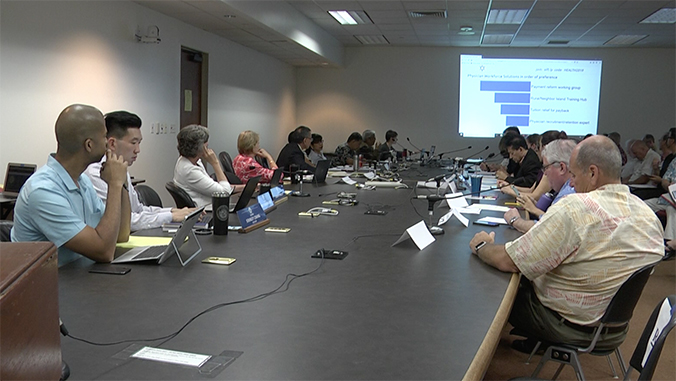
The University of Hawaiʻi and experts from leading healthcare professions provided key insight to hundreds of stakeholders interested in helping to prioritize potential solutions to the state’s health workforce challenges at a recent informational briefing with legislators.
The “Hawaiʻi’s Health Workforce Development for the 21st Century,” briefing was co-chaired by Sen. Rosalyn Baker, chair of the State Senate’s Committee on Commerce, Consumer Protection, and Health, and Rep. John Mizuno, chair of the State House of Representatives’ Committee on Health, and featured 21 speakers, including local and national experts and important state stakeholders. With the support of UH’s UHealthy Hawaiʻi initiative, the goal of the briefing was to ensure robust community engagement in prioritizing potential cross-sector solutions to Hawaiʻi’s health workforce challenges.
The UHealthy Hawaiʻi initiative, which aims to leverage the UH System to improve health and healthcare in Hawaiʻi and the Pacific, has focused its early efforts on optimizing Hawaiʻi’s health workforce.
“We appreciate the support of Chairs Baker and Mizuno in examining the best possible solutions to health workforce challenges in Hawaiʻi,” said UH President David Lassner. “As the state’s sole public higher education institution, we are eager to build on our strong health sciences program to address Hawaiʻi’s health workforce needs.”
Health workforce shortage statewide
Hawaiʻi has numerous health workforce needs and challenges. In 2018, Hawaiʻi had a shortage of 797 physicians across the state, according to the Hawaiʻi/Pacific Basin Area Health Education Center’s 2018 Workforce Report. Additionally, the Hawaiʻi State Center for Nursing 2019 workforce supply data indicate that the advancement of nursing education is the lowest on the neighbor islands.
The need is not only for physicians and nurses. A recent report by the Healthcare Association of Hawaiʻi released in August found 2,200 open non-physician healthcare positions for 76 different patient-facing professions between the last quarter of 2018 to the first quarter of 2019. Some of the key professions in need include: medical assistants, nurse aides, registered nurses in specialty roles, patient service representatives, phlebotomists and physical therapists.
“Absolutely we have a shortage. Absolutely our shortage is worse on the neighbor islands,” said Lt. Gov. Josh Green in his opening remarks. “The menu of solutions that we’re going to hear today include…the way to get forward…We will have to choose what additional training to fund. Any grant or scholarship that we support, I believe that we should ask for a five-year commitment.”
Creating solutions, addressing challenges
The briefing’s second panel showcased potential solutions to Hawaiʻi’s health workforce challenges in different sectors (including entry-level health professions, nursing, medicine, social work, behavioral health, and public health) as well as potential solutions to optimize Hawaiʻi’s health system and address shared workforce challenges.
“The collaboration and political will to address Hawaiʻi’s health workforce challenges demonstrated at this briefing are very promising,” said Aimee Grace, director of Health Science Policy, UH System. “We look forward to continuing to work together with our legislators and public-private partners to advance these efforts to optimize Hawaiʻi’s health workforce through the UHealthy Hawaiʻi initiative.”
A link to the briefing materials, including the presentations, additional testimony, and electronic polling report, can be found at the Senate Committee on Commerce, Consumer Protection, and Health website. The recorded briefing can be found on ‘Olelo.

